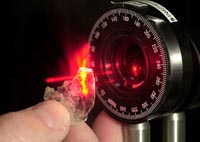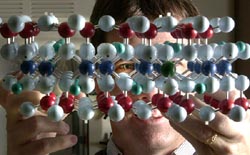Home > News > Old Company Press Releases > Purdue News
Nanometer-thick clay may yield groundbreaking technology
West Lafayette, Ind. April 15th, 2003
An ultrathin film containing 1-nanometer thick clay
particles has been created for the first time, an accomplishment that may
yield new materials and devices for medicine, electronics and engineering,
according to Purdue University and Belgian scientists.
Using a method that captures clay particles on a crystal, Purdue and
Katholieke Universiteit Leuven research partners were able to produce, see
and manipulate a single layer of clay. It would take 70,000 of these layers
to equal the thickness of a human hair. The thickness of one clay particle
is about 1 nanometer, and being able to see one of these layers is
equivalent to standing on Earth and being able to see footprints on the
moon.
The researchers' joint findings will be reported in the May 27 issue of the
journal Langmuir, a publication of the American Chemical Society. The report
is currently on the publication's
Web site.
"Once you can control and manipulate nano-sized clay particles, then you
have the ability to create smart materials by combining the structural
support provided by the clay with the functionality of organic molecules,
such as dye, enzymes, proteins and polymers," said Cliff Johnston, Purdue
professor of agronomy and an environmental chemist. "That allows us to build
the clay and the organic molecules into more complex structures."
This could lead to development of sensors to more quickly detect biological
and chemical agents, the creation of stronger plastics and other materials,
such as self-sealing substances for use on spacecraft.
"When we use an ultrathin hybrid film to make a device, such as a sensor, it
will respond faster than a larger device," said Johnston, who also is a
researcher with the Birck Nanotechnology Center in Purdue's Discovery Park.
Clay minerals already have a variety of uses in products such as
nanocomposites, vaccines, catalysts and plastics. In these materials, the
clay particles consist of many layers.
Creating a film that has a single layer of clay allows researchers to work
with the mineral in new ways. Because clay behaves differently when it's in
bulk form composed of numerous layers, its value multiplies in a
single-layer form, Johnston said.
"We're interested in making clay particles smart materials by combining them
with functional organic molecules to form hybrid materials," he said. "By
doing this, we open a whole spectrum of materials we can develop so they
will respond in a particular way in a particular environment.
"It could be a dye molecule that is one color in the presence of a
particular contaminant or is sensitive to a change in pH or to a whole range
of different things."
Clay particles can provide a semirigid structure or template for organic
molecules, Johnston said. By combining other materials, scientists can
develop new hybrid materials that are malleable and respond in a particular
way.
For instance, clay minerals are currently used to create plastics that are
significantly lighter, stronger and more elastic than those without clay. In
these materials, the clay minerals are present in multiple layers, Johnston
said. This adds stability to the plastic; it melts at a higher temperature;
it's stronger. However, there is limited control over how bulk, multilayer
clay and another substance mix.
"Mixing bulk forms of clay is not the same as working with an individual
layer, which allows you to manipulate it and to place it where you want it,"
he said.
In order to produce, directly see and work with a single layer of clay,
Johnston and Katholieke Universiteit Leuven colleagues started with a
technique called a Langmuir-Blodgett Balance. This involved putting clay
particles into water and then adding insoluble organic molecules that have a
positively charged tip. As the organic molecules float on the water surface,
they attract and bind to the negatively charged clay.
The researchers used a Langmuir trough to force these combined particles
into a line. This is akin to ping-pong balls floating in a pool of water and
then compressing the water so all the balls are together, Johnston said.
Next the scientists inserted a crystal into the water that would attract
floating molecules. When the crystal was pulled out of the water, the
molecules coated its surface, forming a film.
In order to detect the single layer of clay film, the scientists used
infrared techniques, effective because clays absorb infrared light. They
then used an atomic force microscope to see the hybrid film.
The investigators plan to continue their research by exploring different
ways of making the hybrid films and the types of functionality that can be
added or built into the films.
The study's lead author is Robin Ras, a Katholieke Universiteit (K.U.)
Leuven doctoral student in the Center for Surface Chemistry and Catalysis.
The other authors are Robert Schoonheydt, K.U. Agricultural and Applied
Biological Sciences Department dean and director of the Center for Surface
Chemistry and Catalysis; Elias Franses, Purdue professor of chemical
engineering; and K.U. Leuven scientists R. Ramaekers, G. Maes, P. Foubert,
and F. De Schryver.
The Fund for Scientific Research-Flanders, a bilateral agreement
Flanders-Hungary grant and the U.S. Department of Agriculture National
Research Initiative provided funding for this work. Johnston also received a
K.U. Leuven Fellowship.
Writer:
Susan A. Steeves, (765) 496-7481, ssteeves@Purdue.eduSource:
Cliff Johnston, (765) 496-1716, clays@Purdue.eduRelated Web sites:
Cliff JohnstonKatholieke Universiteit Leuven
Purdue Birck Nanotechnology Center
National Nanotechnology Initiative
National Science Foundation
The American Chemical Society
Langmuir
For further information, please contact:
Beth Forbes, Ag News Coordinator
Ag Communications Service
(765) 494-2722
http://persephone.agcom.Purdue.edu/AgCom/news/
Jeanne Norberg, director
Purdue University News Service
400 Centennial Mall Drive, Room 324
West Lafayette IN 47907-2016
Office: (765) 494-2096; Fax: (765) 494-0401
Pager: (765) 423-8662; Cell: (765) 491-1460
Home: (765) 449-4986
jnorberg@Purdue.edu
http://news.uns.Purdue.edu
Reprinted with premission.
Copyright Purdue University.
If you have a comment, please
us.
|
|
||
|
|
||
| The latest news from around the world, FREE | ||
|
|
||
|
|
||
| Premium Products | ||
|
|
||
|
Only the news you want to read!
Learn More |
||
|
|
||
|
Full-service, expert consulting
Learn More |
||
|
|
||

